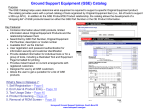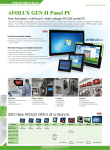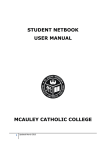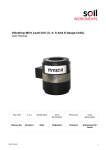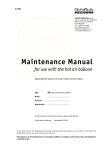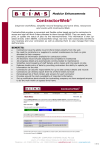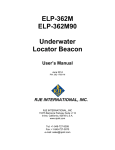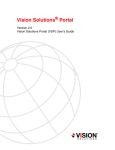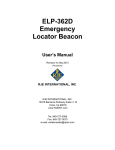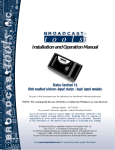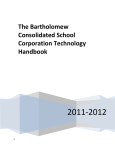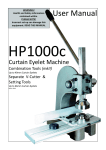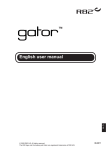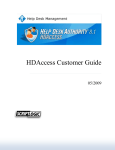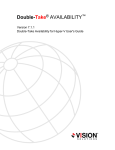Download WP FlexA4.indd
Transcript
Managed Infrastructure W H I T E PA P E R Building and maintaining computer systems is no easy task and information technology managers are constantly looking for better tools to reduce the total cost of managing their data centres and infrastructure. Advances in computer, networking and storage technology allow us to separate the various parts of our infrastructure to specialised platforms. For example, storage area networks have allowed us to separate the data storage from our servers in much the same way that file servers are used to separate data from desktops and provide more robust management functionality such as centralised backup and recoverability. In the past, storing the operating system state and data within the computer caused management challenges such as storage over-provisioning, data duplication and expensive and ineffective backups. Then, shifting data storage to SANs provided many advantages in hard and soft dollar cost savings. The final evolution of storage management is to separate the boot disks from systems and turn them into stateless compute devices. Double-Take® Flex separates state from compute devices and allows them to run from iSCSI SAN. This provides solutions for: Managed desktop – Double-Take Flex allows you to share read-only images across large numbers of desktops, which keeps processing power close to the users while centralising the management of desktop. Then, when software needs patched or upgraded only one image needs to be changed and all desktops instantly receive the new software. Managed servers and blade servers Double-Take Flex separates system state from hardware which lets you quickly provision new servers and move them to different hardware, placing the right workload at the right place at the right time. Managed Desktops How do you provide the best desktop experience to your end-users while still controlling costs and reducing the amount of management associated with caring for the environment over time? Double-Take Flex gives you all of the management capabilities that you need while providing end-users with the desktop experience that they need. Users won’t be competing for shared resources since they have their own dedicated computing resources that provide the most efficient workspace possible. 2 visionsolutions.com W H I T E PA P E R Optimally, IT managers would have centralised management capabilities of thin clients with the power and flexibility of a desktop. Double-Take Flex provides the ability to completely remove the disk storage from your desktops and centralise it on your SAN. Then you can assign individual computer images or groups of images and a selection menu to your desktops. Double-Take Flex works with your existing x86 or x64 operating systems and applications so you don’t have to worry about starting over from scratch with a new platform; you can simply transfer the existing images to your SAN and then assign them to the computer that needs them. For example, if a manager’s office is being renovated and they need to work from a spare cube you can simply click on their computer’s image and reassign it to the computer in the spare cube. If a Double-Take Flex managed desktop becomes infected or corrupt, you don’t have to spend hours trying to diagnose and fix the problem. Double-Take Flex gives you the option to keep your base images in a read-only state and only update them when you are ready. Simply tell the user to turn off the computer’s power and then turn it back on and their desktop is instantly restored to the pristine state that they began the day with; their data is still stored on file servers and application servers safely behind corporate firewalls. Managed Servers, Blades and Virtual Systems Double-Take Flex also provides the same quick provisioning features on server and blade platforms. This allows you to unpack and rack new servers and put them in production within seconds. Just tell Double-Take Flex which of your pre-configured images that the new systems should boot and turn the power on. Once the machine is running you can customise that image with its unique configuration and persist any changes to its image. 3 visionsolutions.com W H I T E PA P E R You can even perform boot-from-SAN from virtualisation platforms, further reducing the time and complexity of managing workloads. Maybe you’ve simply run out of compute power on a heavily used virtualisation server and need to move that workload to another system. However, the two virtual platforms are not on compatible hardware so you can’t use that vendor’s tools to quickly move the workload - or maybe you’re switching virtualisation vendors from VMware® to Microsoft® Hyper-V™. Both problems are solved with a simple click of the mouse for Double-Take Flex. Create a new base virtual machine configuration on the new server – you won’t need any disk resources on it – and then have it boot from the network. Using Double-Take Flex, just point the existing running image to its new server home and then shutdown the old VM and start the new VM on the new host server. The guest will boot, find the Double-Take Flex server and receive its instructions where to find its boot disk on the SAN... then it boots the operating system as normal and starts processing within seconds. Fast Provisioning Provisioning tasks traditionally required installing and configuring the operating system, installing and configuring the applications, service packing and patching all of the software. Fast provisioning with Double-Take Flex reduces the amount of time required to deploy a new computing resource. Historically, disk-imaging technologies have helped IT departments deploy new desktops and servers by eliminating the need to perform installation on each desktop. However, they still require the time to copy new images to each of the computers, making them increasingly unsuitable for the modern enterprise. Plus, disk imaging can take a long time on a moderately sized network because of contention for network resources between the imaging server and the image clients. Worse still is that the clients can’t be used while the imaging process is happening (which can take hours to complete). Thus, many IT organisations have resorted to visiting each computer and replacing hard drives with updated images manually. If a hard drive image becomes infected or corrupt, then the computer becomes unusable until the drive is reimaged or swapped with a new hard drive. 4 visionsolutions.com W H I T E PA P E R Double-Take Flex eliminates image copying and manual hard drive update processes by eliminating the hard drive from the system and centralising the management of system images. When a new computer is deployed, an administrator chooses which image that system should boot and then it’s turned on; the image is loaded dynamically and available within seconds. If a computer image becomes infected or corrupt, then the user or administrator can reboot to a pristine image and continue working as if nothing had happened. Centralised Management Centralised management of computing resources becomes ever more important as the number of desktops and complexity of their applications increase. Many IT organisations have found remote desktop technology useful for centralising the management of desktop applications. However, most end users have learned to despise these infrastructure technologies because they quickly learn to associate them with terms like “inflexible”, “slow” and “unusable”. Still, their premise is simple enough that most desktop computers have much more computing horsepower than the average user needs. There are economies of scale to be achieved by centralising on shared servers. In practice, shared platforms don’t provide enough performance when users need it most. Many organisations end up having to revert their thin client infrastructure back to thick desktops over time because the cost savings simply aren’t enough to make up for losses in productivity and user frustration. Double-Take Flex technology centralises all management of the remaining storage devices in your enterprise. Double-Take Flex uses a completely software- driven platform, which means that you don’t have to purchase expensive boot-from-SAN HBAs for your computers like other boot-from-SAN solutions require. These are highly specialised adapters that are much more expensive than their non-bootable counterparts. In addition to those hard dollar total cost of ownership benefits, Double-Take Flex does not require any hands-on updating process like solutions that require manual firmware flash updates any time that a workload must change. Double-Take Flex boot from SAN solutions are managed anytime, from anywhere, at the click of a mouse. Centralising the physical location of your boot images to SAN allows you to take advantage of technologies such as snapshots, cloning and replication that are native to SAN platforms. Thus, you can create point-in-time copies of your entire data centre at regularly scheduled intervals for fast restoration in cases of logical corruption. You can also clone systems when provisioning new and similar workloads, eliminating the need to build the system or to maintain base images; your existing production systems can be those base images. Additionally, you can develop and test new systems and once the implementation is approved, you simply clone and boot them on their production hardware. SANs can also provide replication functionality that can provide off-site recoverability cost effectively for non-critical workloads that don’t justify a budget for more robust recoverability solutions. Storage replication is perfect for disaster recovery of desktops and tier 3 workloads that have low change rates (such as web servers). Shared Image De-Duplication and Persistence Double-Take Flex also allows computers with similar workload needs to share a common bootable image. This greatly reduces the total amount of storage required by avoiding the duplication inherent in each image’s common operating system and application binaries. User data is stored on database and file servers to keep the images stateless, and each computer can maintain a separate writeable cache to store its own unique configuration such as computer name and network settings. The Double-Take Flex writeable cache can be non-persistent; this keeps the computer’s boot image in a read-only state to prevent corruption by accidental misuse or malicious attacks. 5 visionsolutions.com W H I T E PA P E R Double-Take Flex Systems Architecture The Double-Take Flex architecture is composed of three major functions that work in concert to perform client boot from iSCSI SAN. Clients: Provide the basic compute and memory hardware that run workloads. These can be desktops, servers, blade computers as well as virtual machines, which will boot from an iSCSI SAN rather than direct-attached disks. Clients can be any computer that supports the industry standard Wired for Management PXE protocols. iSCSI SAN: Stores the bootable workload images outside of the client for manageability and recoverability. Double-Take Flex runs on any Windows machine and allows provisioning and sharing of that server’s unused disk resources using iSCSI protocol. Management Server: Matches clients with their iSCSI boot images and any necessary preboot functionality. Boot Process • Client computer begins boot from network process by poling the network for a DHCP server and using the Wired for Management specification. • Double-Take Flex will also respond to the request if the client computer’s MAC address is registered as a network bootable computer. • The client computer receives a bootstrap that provides iSCSI mapping prior operating system boot. • Finally, the client operating system begins to boot, using the disk image stored in the target iSCSI LUN. Changes to the image can optionally save to the boot image or be discarded upon reboot. Double-Take Flex Management Server The Double-Take Flex Management Server provides the services that map available iSCSI boot images to computers and helps facilitate the communication necessary for them to connect and boot from iSCSI SAN. Create Double-Take Flex clients by referencing their Ethernet MAC address and then assign one or more bootable iSCSI target LUNs. There are advanced options that provide failover functionality to split boot loads between different iSCSI storage devices and provide failover for boot redundancy. If a client has more than one image assigned to it, you can also provide a menu to the user that allows them to select the image that they want to boot at that moment. Later, they can reboot and select a different image when they finish the previous task. This solution works well by providing full CPU power directly to the users while maintaining full centralised management capabilities. ISCSI SAN and Double-Take Flex Double-Take Flex uses industry standard communication protocols and your entire existing infrastructure. iSCSI storage provides the most cost-effective total cost of ownership because it doesn’t require any specialised hardware, whereas fiber channel-based solu- 6 visionsolutions.com W H I T E PA P E R tions require very expensive HBA adapters in each computer to provide basic connectivity to fiber channel storage and redundancy against failure. Double-Take Flex can use your existing iSCSI storage by building out LUNs and then pointing clients to that storage. If you don’t have iSCSI storage in your data centre or if you would like to continue using your investment in direct-attach or fiber channel storage, Double-Take Flex from Double-Take® Software can help. Double-Take Flex is software that runs on any Microsoft Windows computer and provides iSCSI target services to your network. You create iSCSI disks with Double-Take Flex that reside as file on that server’s disks in the Microsoft VHD (Virtual Hard Drive) format, then Double-Take Flex makes those target LUNs available to your boot- from-SAN clients using cost-effective Ethernet and IP protocol. For more information call: +44(0) 333 1234 200 or visit www.visionsolutions.com 15300 Barranca Parkway Irvine, CA 92618 800-957-4511 801-799-0300 visionsolutions.com © Copyright 2010, Vision Solutions, Inc. All rights reserved. IBM, AIX and Power System are trademarks of International Business Machines Corporation. EO_UMWA_E_1005








